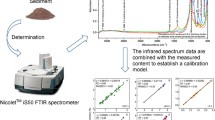Abstract
A comparison of results from two methods (loss on ignition and wet oxidation) for estimating organic content of sediments shows close correspondence in values over a range of organic contents. For this case study of samples from the Sunwapta Pass area, loss on ignition provides a reasonable estimate of organic content.
Similar content being viewed by others
References
Ball D.F. 1964. Loss-on-ignition as an estimate of organic matter and organic carbon in non-calcareous soils. J. Soil Sci. 15: 84-92.
Beaudoin A.B. 1984. Holocene Environmental Change in the Sunwapta Pass Area, Jasper National Park, PhD, University of Western Ontario, Department of Geography, London, Ontario, Canada, 487 pp. (unpublished).
Beaudoin A.B. and King R.H. 1990. Late Quaternary vegetation history of Wilcox Pass, Jasper National Park, Alberta. Palaeogeog., Palaeoclim., Palaeoecol. 80: 129-144.
Bengtsson L. and Enell M. 1986. Chemical analysis. In: Berglund B.E. (ed.), Handbook of Holocene Palaeoecology and Palaeohydrology. John Wiley & Sons, Chichester, England, UK, pp. 423-451.
Boyle J.F. 2001. Inorganic geochemical methods in paleolimnology. In: Last W.M. and Smol J.P. (eds), Tracking Environmental Change Using Lake Sediments: Volume 2: Physical and Geochemical Methods. Developments in Paleoenvironmental Research. Kluwer Academic Publishers, Dordrecht, The Netherlands, pp. 83-141.
Dean W.E. Jr 1974. Determination of carbonate and organic matter in calcareous sediments and sedimentary rocks by loss on ignition: comparison with other methods. J. Sed. Pet. 44: 242-248.
Heiri O., Letter A.F. and Lemeke G. 2001. Loss on ignition as a method for estimating organic and carbonate content in sediments: reproducibility and comparability of results. J. Paleolim. 25: 101-110.
Hesse PR. 1971. A Textbook of Soil Chemical Analysis. John Murray, London, UK, 520 pp.
Mackereth F.J.H. 1966. Some chemical observations on post-glacial lake sediments. Phil. Trans. Roy. Soc. Ser. B 256: 165-213.
McGill W.B. 1976. Total C, N, S, and P. In: McKeague J.A. (ed.), Manual on Soil Sampling and Methods of Analysis. Prepared by Subcommittee on Methods of Analysis of Canadian Soil Survey Committee. Ottawa, Ontario, Canada., pp. 106-137.
McKeague J.A. (ed.) 1976. Manual on Soil Sampling and Methods of Analysis. Prepared by Subcommittee on Methods of Analysis of Canadian Soil Survey Committee. Ottawa, Ontario.
Meyers PA. and Teranes J.L. 2001. Sediment organic matter. In: Last W.M. and Smol J.P. (eds), Tracking Environmental Change Using Lake Sediments: Volume 2: Physical and Geochemical Methods. Developments in Paleoenvironmental Research. Kluwer Academic Publishers, Dordrecht, The Netherlands, pp. 239-269.
Sheldrick B.H. (ed.) 1984. Analytical Methods Manual 1984. Research Branch, Agriculture Canada, Ottawa, Ontario, Canada, LRRI Contribution No. 84-30.
Author information
Authors and Affiliations
Rights and permissions
About this article
Cite this article
Beaudoin, A. A comparison of two methods for estimating the organic content of sediments. Journal of Paleolimnology 29, 387–390 (2003). https://doi.org/10.1023/A:1023972116573
Issue Date:
DOI: https://doi.org/10.1023/A:1023972116573




